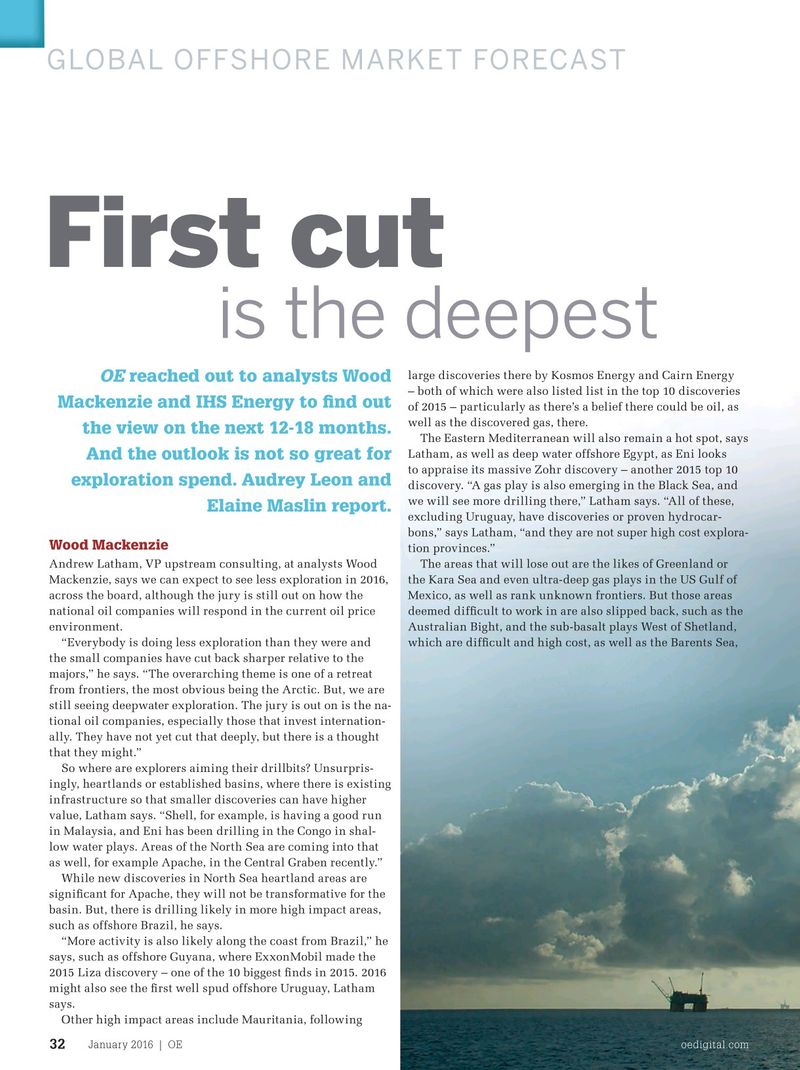
Page 30: of Offshore Engineer Magazine (Jan/Feb 2016)
Read this page in Pdf, Flash or Html5 edition of Jan/Feb 2016 Offshore Engineer Magazine
GLOBAL OFFSHORE MARKET FORECAST where exploration results have been mixed.
Meanwhile, areas where there have been high levels of exploration, will also fall off the exploration radar, as the focus moves towards commercialization, such as East Africa, where giant gas discoveries were made offshore Tanzania and
Mozambique in recent years.
As we move into 2017-2018, the results from the recent, strong offshore Newfoundland round, including drilling com- mitments, might start to bear from, says Latham, as well as offshore Mexico.
A wild card could be future prospects for ? oating LNG, as
First cut a development solution for small scale resources in basins where the potential for onshore LNG trains isn’t attractive. “This is getting some attention in parts of the world that don’t have challenging maritime conditions, speci? cally West
Africa, Cameroon, Equatorial New Guinea with the likes of is the deepest
Ophir and Perenco,” says Latham. Golar LNG, a partner on both, is con? dent there is plenty more to come. large discoveries there by Kosmos Energy and Cairn Energy -Elaine Maslin
OE reached out to analysts Wood – both of which were also listed list in the top 10 discoveries
IHS Energy
Mackenzie and IHS Energy to ? nd out of 2015 – particularly as there’s a belief there could be oil, as well as the discovered gas, there. For explorationists, the next 12-18 months will be a dif? cult the view on the next 12-18 months.
The Eastern Mediterranean will also remain a hot spot, says road. For most companies, exploration is the easiest to cut if
Latham, as well as deep water offshore Egypt, as Eni looks you are looking to reign in capex, says Rebecca Fitz, a senior
And the outlook is not so great for to appraise its massive Zohr discovery – another 2015 top 10 director for IHS Energy. She explains: “There are very few exploration spend. Audrey Leon and discovery. “A gas play is also emerging in the Black Sea, and we will see more drilling there,” Latham says. “All of these,
Elaine Maslin report.
excluding Uruguay, have discoveries or proven hydrocar- bons,” says Latham, “and they are not super high cost explora-
Wood Mackenzie tion provinces.”
Andrew Latham, VP upstream consulting, at analysts Wood The areas that will lose out are the likes of Greenland or
Mackenzie, says we can expect to see less exploration in 2016, the Kara Sea and even ultra-deep gas plays in the US Gulf of across the board, although the jury is still out on how the Mexico, as well as rank unknown frontiers. But those areas national oil companies will respond in the current oil price deemed dif? cult to work in are also slipped back, such as the environment. Australian Bight, and the sub-basalt plays West of Shetland, “Everybody is doing less exploration than they were and which are dif? cult and high cost, as well as the Barents Sea, the small companies have cut back sharper relative to the majors,” he says. “The overarching theme is one of a retreat from frontiers, the most obvious being the Arctic. But, we are still seeing deepwater exploration. The jury is out on is the na- tional oil companies, especially those that invest internation- ally. They have not yet cut that deeply, but there is a thought that they might.”
So where are explorers aiming their drillbits? Unsurpris- ingly, heartlands or established basins, where there is existing infrastructure so that smaller discoveries can have higher value, Latham says. “Shell, for example, is having a good run in Malaysia, and Eni has been drilling in the Congo in shal- low water plays. Areas of the North Sea are coming into that as well, for example Apache, in the Central Graben recently.”
While new discoveries in North Sea heartland areas are signi? cant for Apache, they will not be transformative for the basin. But, there is drilling likely in more high impact areas, such as offshore Brazil, he says. “More activity is also likely along the coast from Brazil,” he says, such as offshore Guyana, where ExxonMobil made the 2015 Liza discovery – one of the 10 biggest ? nds in 2015. 2016 might also see the ? rst well spud offshore Uruguay, Latham says.
Other high impact areas include Mauritania, following
January 2016 | OE oedigital.com 32 032_OE0116_Feature3_Analyst.indd 32 12/24/15 1:22 AM

 29
29

 31
31